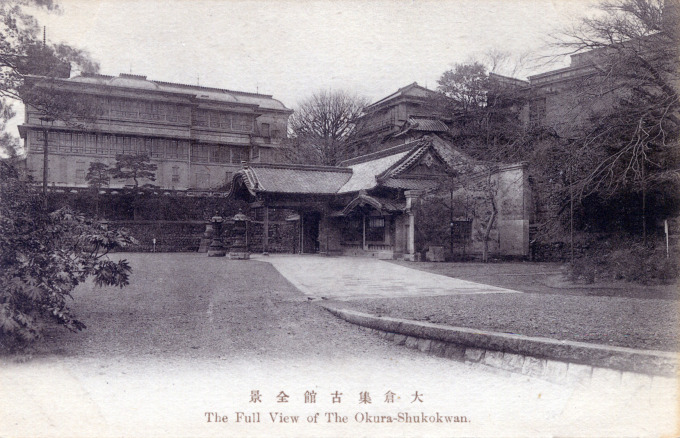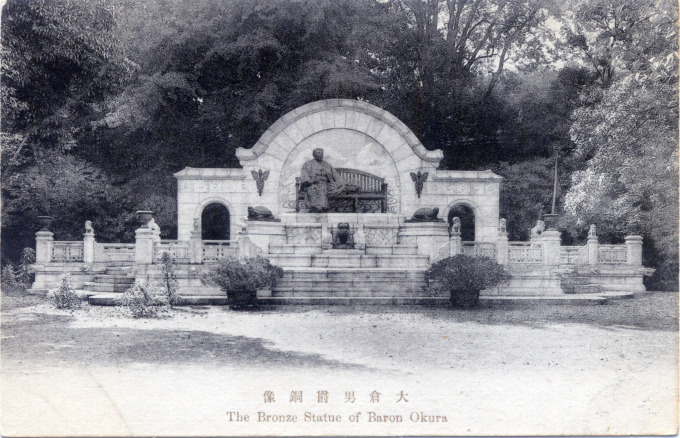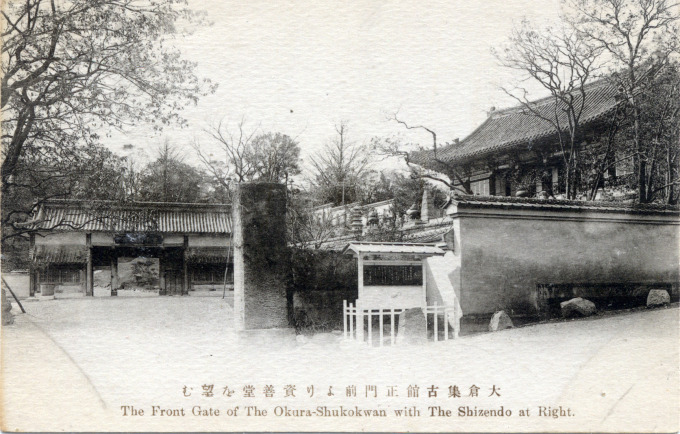
The Full View of the Okura-Shukokwan, c. 1920. The Okura Museum of Art was the first private museum in Japan, built to house the collection of pre-modern Japanese and East-Asian Art amassed since the Meiji Restoration by industrialist Baron Okura Kihachiro. The original museum (seen here) and all the exhibits on display were destroyed in the 1923 Great Kantō earthquake although works then in storage survived. Rebuilt in 1927, the Okura Museum today includes some 2,500 works, among which are three National Treasures and twelve Important Cultural Properties.
See also:
Okura Kumi (Okura Partners), Ginza, 1921
Hotel Okura, Tokyo, c. 1970.
Imperial Hotel (1890-1923).
“To the lover of Oriental art there can be no place better worthy of a visit in Tokyo than the museum owned by K. Okura. The handsome building in which his treasures of art are installed stands crowning in the Reinanzaka hill in Akasaka, which last, when translated into the English tongue, means ‘the red hill’.
“The mercantile firm of Okura & Co. stands in the lead among the best firms in Japan, but aside from his active business career of the last fifty years Mr. Okura has done more than any one individual to preserve to his country the art treasures of Japan.
“In the year 1880, Mr. Okura commenced this work of preservation, one of his large purchases at that time being a complete Shogun shrine. The enforced separation of Buddhism and Shintoism brought sacred articles belonging to both religions upon the market, and for thirty-five years Mr. Okura has added to his collection whenever an opportunity offered.
“The entire museum is open for the inspection of the public free of charge on presentation of permits which are obtainable at any of the embassies.”
– “Tokyo, the Leading City of the Far East”, by C.E. Ferguson, Overland Monthly, Vol. 55, January, 1910
“It is not improbable that the first plunge into Oriental art on Japanese soil should be taken by another foreigner as it was by me in viewing the collection of Baron Okura at his museum in Tokyo.
“This is a great house filled in all its rooms and stories with Asiatic antiques. Here are hundreds of remarkable bronze figures of Buddha from Tibet, Siam, China and Korea as well as from the ancient shrines of Nippon.
“Hindu divinities abound. Kwannon, goddess of mercy and help to man, some examples with eleven heads; other with two score of hands, each holding an emblem of toil are here in scores. The terrible threatening Deva gods mostly in carved wood who guard the temples are here in dozens. Woe, you say, to the evil spirits whom ill-advised malignity send in their direction.
“And these, it is well to know, reveal the outward signs of a great religion generation after generation, from many lands of the East, the most modern three hundred and the most ancient thirteen hundred years old.
“… Here first I saw great examples of the golden lacquer work in boxes and desks and netsuke whose graven work of gold upon gold is a dream of artistry, also lacquer work in larger variety of sealing-wax red. The collection is one of the glories of the nation and has been made by a man who built his own fortune, and active today at eighty, mingles his business and his archeology with the enthusiasm of twenty-five.”
– Japan at First Hand: Her Islands, Their People, by Joseph Ignatius Constantine Clarke, 1918

Bronze statue of Baron Okura, c. 1920. In contrast to most of the zaibatsu (literally, “financial clique”; industrial conglomerates), the Okura zaibatsu was founded by someone from the peasant class. After becoming a grocer in 1857, Okura became a weapons dealer during the turbulent years between the arrival of the Black Ships and the eventual overthrow in 1868 of the Tokugawa Shogunate. Later, Okura founded the first foreign-style tailor shop in Japan. In 1872 he opened a branch office in London, being the first Japanese to establish an overseas branch of any business in the West.
“There was, as every art-enthusiast knows, a psychological moment in the history of collecting in Japan. This was about 1868-1870, at the time of the Restoration, and for some years later, when the Japanese, absorbed in the necessity of modernizing their national life, were seized with a sort of reaction of contempt for their old arts. Old lacquer-ware, now priceless, was then being sold so cheaply that dealers sometimes asserted it would be more profitable to burn it in order to collect the gold it contained.
“It was just at this moment that [Baron Kihachiro] Okura, then an enterprising young merchant, began collecting. He seems to have proceeded from the first on a large and well-considered plan with the aim of forming a collection which, whether it actually became national property or not, would be a credit to his country.
“The Museum occupies three buildings, one a handsome three-storied structure being formerly the residence of the owner. It is open Sundays and weekdays with the exception of Mondays, from 9 till 3 during the winter half and till 4 during the summer half of the year.”
– “The Okura Fine Art Museum, by Charles A. Parry, The Tourist, March 1921



Pingback: Imperial Hotel (1890-1922). | Old Tokyo
Pingback: Okura Kumi (Okura Partners), Ginza, 1921. | Old Tokyo
Pingback: Hotel Okura, Tokyo, c. 1970. | Old Tokyo